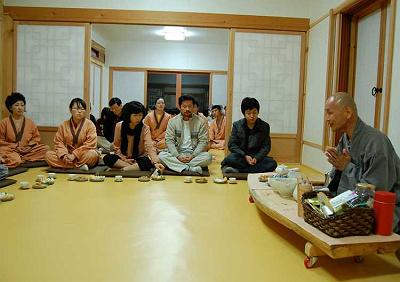
|
|
|
Home Asia Pacific North Asia S/N Korea Temple Stay Overnight sensationBY LORI RACKL, Chicago Times, August 2, 2009ODAESAN NATIONAL PARK, Korea -- The brochure promised peacefulness, a chance to relax, meditate and find serenity in a Korean Buddhist temple.
I’d spend 24 hours living among dozens of monks, nuns and a few other curious folks like me who’d reserved a slot in South Korea’s increasingly popular “temple stay” program. I’d spend 24 hours living among dozens of monks, nuns and a few other curious folks like me who’d reserved a slot in South Korea’s increasingly popular “temple stay” program. I woke early that morning in my comfortable king size bed at the Grand Intercontinental Hotel in Seoul and headed for the subway to begin a transportation odyssey that included a bus ride to the other side of the Korean peninsula, to the town of Jinbu.
I felt like an “Amazing Race” contestant as I searched the streets of Jinbu for an English speaker who could translate my need for a taxi (that accepted credit cards) to shepherd me through the last leg of my journey to Woljeongsa Temple. When I finally arrived around 2 p.m. at the ancient temple tucked into the mountainous Odaesan National Park, the place was about as peaceful and relaxing as the Taste of Chicago. People of all ages were weaving in and out of Woljeongsa’s intricately painted buildings, walking around the grounds’ cherry blossom and pine trees, and reading the wish lists dangling from hundreds of colorful paper lanterns strung overhead. This was no ordinary day. Today marked the birthday of Buddha, who turned a ripe old 2,553, explained the friendly woman who heads up temple stays at Woljeongsa. Her business card read Eunmi Kim, but she told me to call her Gina. South Koreans celebrate Buddha’s birthday on different dates each year, depending on the lunar calendar. This year it fell during the full moon on May 2, which made finding a quiet Buddhist temple a bit like finding an empty church on Christmas. “In Korean temples, we earn the money for the whole year on this one day,” Gina said. She had an equally friendly English-speaking volunteer show me to my room, a spartan little square in a secluded corner of the temple grounds. Clean, bright and lacking any trace of furniture, the 10-by-10-foot cubicle had heated floors that would double as my bed. One door led to my private bathroom; the other, a closet containing thick pads to sleep on and a tiny pillow as firm as a phone book. Another smiling volunteer knocked on my sliding door to deliver my temple stay uniform: an oversized cantaloupe orange jacket and matching M.C. Hammer-style pants. I was about to find out how practical baggy clothing can be at a Buddhist temple, where worshipping is more like a workout. A typical temple stay in Korea lasts at least 24 hours, although some people spend weeks here. What you do during those 24 hours varies from temple to temple, but most programs include the basics: meditation and yoga, tea with a monk, a temple tour, maybe hiking or lotus lantern making, and, of course, Buddhist ceremonies — including one at the unholy hour of 4 a.m. “That is when we start our day,” Gina explained, “because we believe everything has a rhythm, and that is the time that everything in nature is waking up.” Not this cowgirl. But when in a Buddhist temple ... The concept of temple stays really kicked off when South Korea hosted the World Cup in 2002. Korean tourism officials encouraged temples to host foreigners overnight both to ease an accommodation shortage and give visitors an inside look at this slice of Korean culture. The temple stay program lasted long after the soccer fans went home. In 2002 some 33 temples participated. These days, close to 100 welcome overnight visitors. Roughly a quarter of them have English-speaking translators. Guests usually pay a nominal fee — around $24 to $56 — to cover lodging, activities and meals, which are vegetarian and about as basic as they come. Eating at Woljeongsa was — and I mean this in the nicest possible way — a bit like I’d imagine eating in prison, minus the fear of getting shanked. Monks, nuns, monks- and nuns-in-training and temple stay participants filed downstairs into a nondescript cafeteria. With everyone dressed in similar uniforms, we lined up to fill our metal bowls with white rice or plain noodles that can be dressed up with a bit of bland broth or the ubiquitous Korean staple of fermented cabbage, radish or other vegetable known as kimchi. When the meal was over, everyone washed their own dishes. But no one does a temple stay for the great gastronomy. They come because they want to quiet their cluttered mind, get a deeper understanding of Buddhism, or just get a glimpse of what it’s like to live a monastic life. “Only about 10 percent of our visitors are [foreign tourists],” Gina said. The rest are from Korea, “and most of them are not Buddhists. They’re Catholic or not religious. They come because they’re curious. They want to learn.” Among the things I learned: • Take off your shoes before entering the temple and don’t turn your back on statues of Buddha; that’s disrespectful. • The swastika-looking symbols on the prayer mats have nothing to do with Hitler. • Buddhist monks can be quite chatty, especially when they’re leading an evening tea ceremony and you need to go to bed because you have to wake up at 4 a.m. • Buddhists and I have very different definitions of the word “bow.” This rookie thought “bow” meant a simple bend at the waist, so I didn’t give it much thought when my temple stay schedule said I was supposed to do “108 bows for harmonious life” at 10:30 the next morning. But these bows involve a much more elaborate series of motions that had me kneeling on my prayer mat, getting on all fours, touching my forehead to the ground, lifting my palms to the ceiling and standing back up, with my hands in the prayer position. One hundred and eight times. It was humbling to be in the temple, watching people twice my age effortlessly execute bow after bow as I clumsily tried to mimic their motions. In fact, everything felt humbling at Woljeongsa, probably because the entire experience was so unlike anything I’d ever seen or done. I felt like the proverbial fish out of water, bumbling through my bows, inadvertently showing my backside to Buddha — even fumbling with my chopsticks as I tried to pick up a gelatinous piece of rice cake after our monk-led evening walk in the woods with glowing paper lanterns. Once I’d sent a second square of rice cake plummeting to the ground, a sympathetic Korean temple stay guest motioned for me to use my fingers instead. “Natural chopsticks,” he said, grinning as he held up his thumb and pointer finger. Another thing I learned: • Faux pas are easily forgiven at a temple stay. |
 |
|
| Korean Buddhist News from BTN (Korean Language) |
|
 |
|
|
Please help keep the Buddhist Channel going |
|
| Point
your feed reader to this location |
|

 << A Buddhist monk leads an evening tea ceremony for temple guests at Woljeongsa Temple in South Korea.
<< A Buddhist monk leads an evening tea ceremony for temple guests at Woljeongsa Temple in South Korea.

